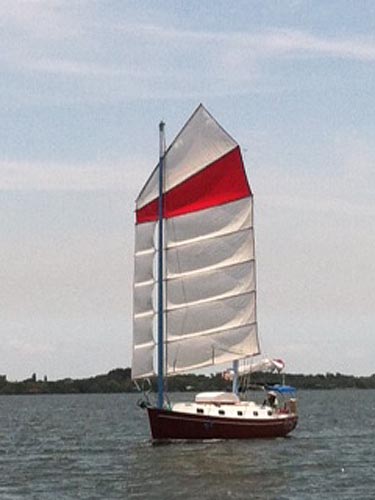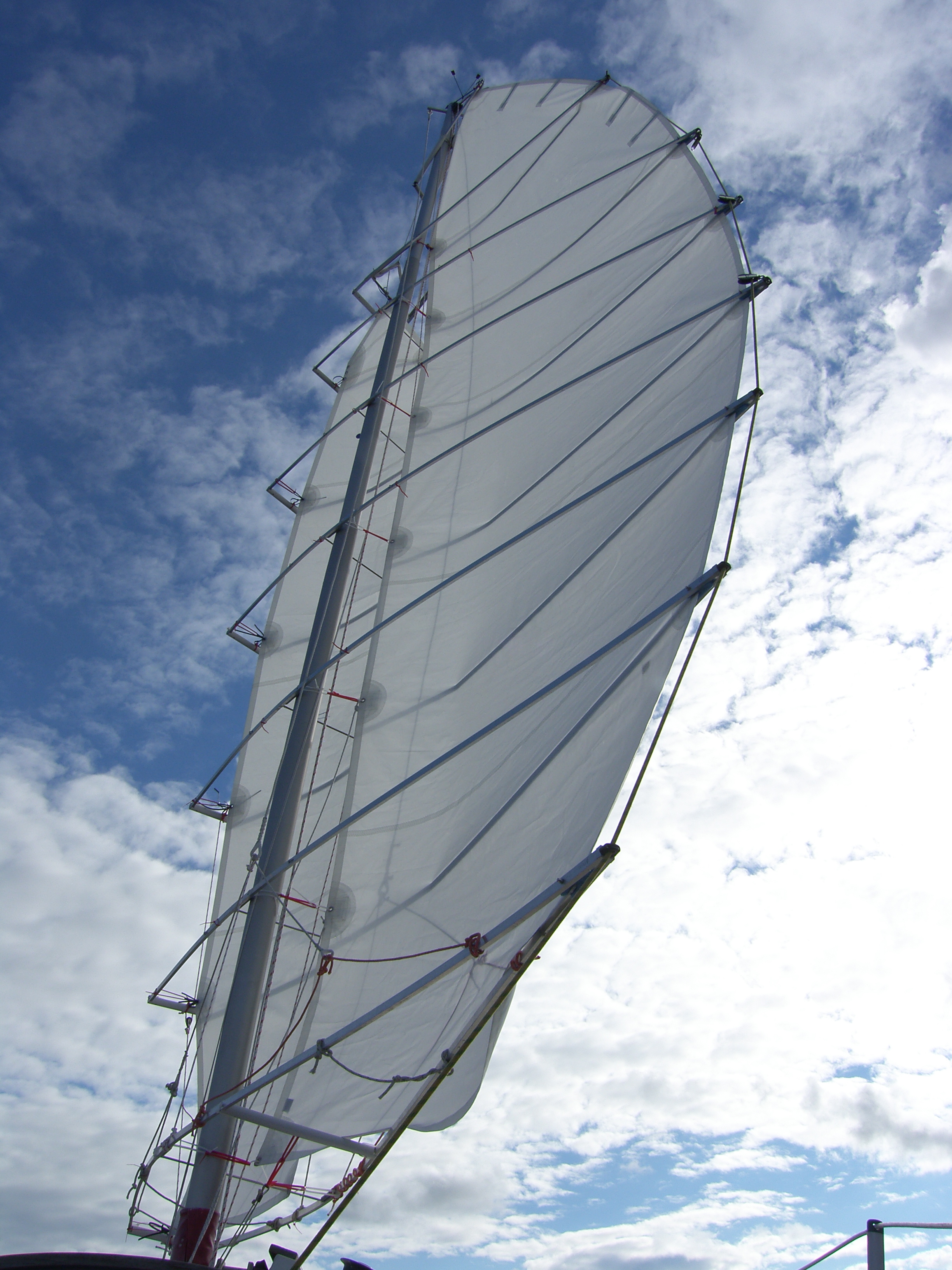I think you are responding to two
different posters here......... Someone else wrote about the math
stuff ;-)
As far as the junk rig, there are so many iterations out there now that saying that the sail plan generally sucks is not very realistic. The modern camber panel designs can have very good airfoil shape in the panels.
 and with the
split junk rig, the mast does not spoil the shape on one tack as
it resides within the split.
and with the
split junk rig, the mast does not spoil the shape on one tack as
it resides within the split.  . The aerojunk which uses flat sail
panels that are shaped by laying against the battens of a batten
cage is better yet, as the batten cage is designed to shift so the
mast is far enough away to avoid spoiling airflow.
. The aerojunk which uses flat sail
panels that are shaped by laying against the battens of a batten
cage is better yet, as the batten cage is designed to shift so the
mast is far enough away to avoid spoiling airflow. Note that the foresail here shifts
farther to one side than the main, creating a very controlled slot
effect. The batten cage is actually very light weight... it can
be much lighter than ordinary battens due to being three
dimensional. With this rig, you can actually adjust the camber
fairly quickly and easily, though not with the sail up. Many of
these sails have very good shape.
Note that the foresail here shifts
farther to one side than the main, creating a very controlled slot
effect. The batten cage is actually very light weight... it can
be much lighter than ordinary battens due to being three
dimensional. With this rig, you can actually adjust the camber
fairly quickly and easily, though not with the sail up. Many of
these sails have very good shape.
You speak of foil plan and sail plan and airfoil profile, all in the same sentence somewhat confusingly. Sail plan to me means all the sails on a boat. On a junk rig, there is often just a single sail that encompasses all of the sail area that would be found on the foresail and main sail. Obviously the split junk and aerojunk version of the split junk have essentially a separate jib that shares battens with the main, and goes up and down with the main.
The purpose for using the junk rig is that it greatly reduces labor in sailing, and is a vastly more rugged sail as the wind loads are carried through the battens and thus divided by the number of battens. On a bermuda rig all loads must be carried through the luff, leech, and foot. On the junk, each panel needs only to transmit the load to the two adjacent battens, which was why it was developed by the Chinese to begin with. They used things like bamboo matting for sails, and other low strength materials.
ALL of the expensive hardware needed on a Bermuda rig is eliminated on a junk rig. You have no need of winches, there is no vang, or traveler, no sail track or cars, and best of all no standing rigging or chain plates, etc. A junk rig is normally sailed without ever leaving the cockpit. Blondie Hassler sailed the Atlantic in the first Ostar in Jester, an ordinary Nordic Folkboat with no cockpit, using a round hatch in the roof to adjust the sail, and came in second to Francis Chichester in a far larger boat. He never left the cabin in the entire crossing........... "Sailed the Atlantic in bedroom slippers" as he put it. And this with a flat, non cambered junk rig.
The truth is that the camber panel junk rig probably on average has a better foil profile than the average Bermuda rig sailed typically........... not by a professional racing crew. A great deal is involved in getting the sail to the optimum shape, and getting the two sails to interact properly, and from what I've seen, most sailors don't do it very well.
H.W.
On 06/04/2018 10:47 PM, Michael Gehl mike@vail.net [harryproa] wrote:
As far as the junk rig, there are so many iterations out there now that saying that the sail plan generally sucks is not very realistic. The modern camber panel designs can have very good airfoil shape in the panels.
 and with the
split junk rig, the mast does not spoil the shape on one tack as
it resides within the split.
and with the
split junk rig, the mast does not spoil the shape on one tack as
it resides within the split.  . The aerojunk which uses flat sail
panels that are shaped by laying against the battens of a batten
cage is better yet, as the batten cage is designed to shift so the
mast is far enough away to avoid spoiling airflow.
. The aerojunk which uses flat sail
panels that are shaped by laying against the battens of a batten
cage is better yet, as the batten cage is designed to shift so the
mast is far enough away to avoid spoiling airflow. Note that the foresail here shifts
farther to one side than the main, creating a very controlled slot
effect. The batten cage is actually very light weight... it can
be much lighter than ordinary battens due to being three
dimensional. With this rig, you can actually adjust the camber
fairly quickly and easily, though not with the sail up. Many of
these sails have very good shape.
Note that the foresail here shifts
farther to one side than the main, creating a very controlled slot
effect. The batten cage is actually very light weight... it can
be much lighter than ordinary battens due to being three
dimensional. With this rig, you can actually adjust the camber
fairly quickly and easily, though not with the sail up. Many of
these sails have very good shape.You speak of foil plan and sail plan and airfoil profile, all in the same sentence somewhat confusingly. Sail plan to me means all the sails on a boat. On a junk rig, there is often just a single sail that encompasses all of the sail area that would be found on the foresail and main sail. Obviously the split junk and aerojunk version of the split junk have essentially a separate jib that shares battens with the main, and goes up and down with the main.
The purpose for using the junk rig is that it greatly reduces labor in sailing, and is a vastly more rugged sail as the wind loads are carried through the battens and thus divided by the number of battens. On a bermuda rig all loads must be carried through the luff, leech, and foot. On the junk, each panel needs only to transmit the load to the two adjacent battens, which was why it was developed by the Chinese to begin with. They used things like bamboo matting for sails, and other low strength materials.
ALL of the expensive hardware needed on a Bermuda rig is eliminated on a junk rig. You have no need of winches, there is no vang, or traveler, no sail track or cars, and best of all no standing rigging or chain plates, etc. A junk rig is normally sailed without ever leaving the cockpit. Blondie Hassler sailed the Atlantic in the first Ostar in Jester, an ordinary Nordic Folkboat with no cockpit, using a round hatch in the roof to adjust the sail, and came in second to Francis Chichester in a far larger boat. He never left the cabin in the entire crossing........... "Sailed the Atlantic in bedroom slippers" as he put it. And this with a flat, non cambered junk rig.
The truth is that the camber panel junk rig probably on average has a better foil profile than the average Bermuda rig sailed typically........... not by a professional racing crew. A great deal is involved in getting the sail to the optimum shape, and getting the two sails to interact properly, and from what I've seen, most sailors don't do it very well.
H.W.
On 06/04/2018 10:47 PM, Michael Gehl mike@vail.net [harryproa] wrote:
You use that phrase “nth order variable”. I do not think it means what you think it means. - Inigo Montoya, in the Princess Bride.
I think you mean - “of secondary (or tertiary, etc.) importance”.
Second order actually implies a higher level of complexity; a second-order differential equation involves a second derivative.
Not to be pedantic, or anything like that ;-)
Also, with a junk rig, since the foil plan (sail plan) usually sucks, aerodynamically, the foil profile (airfoil profile) assumes greater importance, and location of max. draft means a lot more.
On Jun 2, 2018, at 9:44 AM, '.' eruttan@yahoo.com [harryproa] <harryproa@yahoogroups.com.au> wrote:
____________________________________
Note: I will be retiring the mike@vail.net email address shortly. Please update my address in your contacts to mike@gehlvail.net
Thanks.
__._,_.___
Posted by: StoneTool <owly@ttc-cmc.net>
| Reply via web post | • | Reply to sender | • | Reply to group | • | Start a new topic | • | Messages in this topic (143) |
.